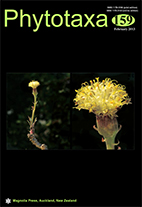Abstract
The systematic position of Paraixeris humifusa (Asteraceae) is hard to define, because the circumscription of Paraixeris, Youngia and Crepidiastrum, three closely related genera in subtribe Crepidinae (Cichorieae), is not clear. This paper reports on the relationships between 30 species in subtribe Crepidinae, based on an analysis of nucleotides from one nuclear (ITS) and three chloroplast DNA regions ( trnL-F, rps16 and atpB-rbcL). The phylogenetic analyses used maximum parsimony with maximum likelihood inference. The monophyly of Crepidiastrum in the most recent generic classification of Shih & Kilian (2011) is explored. The results show that 12 species in Crepidiastrum constitute a monophyletic group, and that Paraixeris humifusa should be treated as Youngia humifusa.

